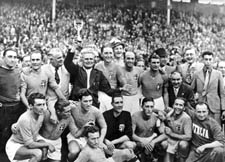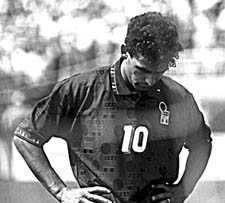
Vittorio Pozzo with the World Cup and his winning team after the victory in the final against Hungary in Paris in 1938.

John Foot

Roberto Baggio misses a penalty in a shoot-out, handing the World Cup to Brazil in 1994. Pictured page one: Franco Beresi of Milan is warned by one of the world's greatest referees, Pierluigi Collina, in 1993 |
'Ammalato come pappagallo'
(That's 'sick as a parrot' in Italian)
The beautiful game in Italy is actually rather ugly writes David Winner
Calcio: A History Of Italian Football
by John Foot
Fourth Estate, £15 order this book
IN a startling preface to his meticulous and well-written history of Italian football, John Foot compares himself to the Malcolm McDowell character in A Clockwork Orange.
"I have been forced to watch things that in the end have made me sick," says Foot. "I did not think it would be possible, but, by the end, I had almost fallen out of love with football."
A decade ago Italian football was the bee's knees. Serie A featured most of the world's A-list talents. The Tifosi (fans) were famed for their passion. And super-cool stars like Roberto Baggio, Paolo Maldini and Alessandro Del Piero epitomised style, skill and poise.
Now, though, like other parts of Italian life (opera, politics, the economic system) Calcio is in trouble.
Attendances are falling. Endemic corruption, hysteria, racism, cynicism and outdated defensive tactics undermine the game. And Serie A is widely regarded as inferior to the leagues of Spain and England.
Much more worrying is the close parallel with English football in the 1980s: Italy's hooligans are out of control.
Authorities, clubs, the police and ordinary fans seem powerless in the face of the highly-organised 'ultras' whose viciousness and fascism routinely
swirls around Italian stadiums.
Violence now "pervades all levels of the Italian game" and stadiums have become places "where nobody in their right mind would take a child." Foot argues that Italy has learned nothing from the English experience. He fears an Italian equivalent of the Heysel or Hillsborough disasters may be imminent.
Yet, in a book that runs to 565 pages, such melancholy contemplation is only a small fraction of an amazingly rich, century-old story.
Ultimately, Foot finds it impossible not to remain in love with what is still one of the world's most important and distinctive football cultures. He concludes that the beautiful game can no longer be described as beautiful ('especially in Italy') but "all is not lost".
Foot is a scholar - he is reader in modern Italian history at University College London. But don't let that put you off. This crisp, authoritative and often witty book gives academics a good name.
He covers everything from political chicanery and bribery and doping scandals to the fans' love-hate relationship with the national team which, with so much talent available, should have won more than one world cup since 1938. The history is solid and engaging. He has fun, for example, describing the crucial early English influence.
A doctor from Stoke Newington organised the first official game and created Italy's first big club, Genoa. In Lombardy, a journeyman player from Nottingham became founding father and first star of AC Milan. An obscure outfit in Turin decided to call themselves Juventus and adopted the black and white striped shirts of then-mighty Notts County.
Foot provides moving accounts of the Superga disaster in 1949, which wiped out Il Grande Torino, one of Italy's greatest teams, and Gigi Meroni, a George Best-like winger accidentally run over and killed by one of his biggest fans at the age of 24.
One intriguing chapter explains why Italians hate referees and blame them for everything that goes wrong.
Italians, for example, still blame humiliating defeat by South Korea in the 2002 World Cup on the referee rather than their own bad tactics.
Foot writes: 'For the Italian football fan, the referee is always corrupt. What remains to be discovered is how he is or has been corrupt, in favour of whom, and why."
He traces this to Italy's "egitimation crisis". Just as the state itself has always been viewed with suspicion, so the basic rules of football have never quite been accepted.
Fair play is an alien concept and Italians confusingly view referees with both contempt and respect.
"Respect is for the authority they wield and the institutional position they hold. As individuals they are despised," says Foot.
He doesn't come up with a new theory to explain why Italian football developed its trademark defensiveness. But he clearly traces the emergence and decline of the 'catenaccio' system of blanket defence.
He also makes clear that alongside ubiquitous stifling tactics and "destroyers of the play", Italians always loved the beauty and creativity of the fantasisti - those players with fantasy or imagination on the pitch.
Italy's greatest football writer Gianni Brera
thought a 0-0 draw was "the perfect game". Yet the country's favourite football memory is the "game of the century", the astounding 4-3 extra time victory against West Germany in the semi-final of the 1970 World Cup. Exhausted by the heat and altitude of the Azteca Stadium in Mexico, the Italians that day simply decided to abandon fear. The socialist writer Nando Della Chiesa described their thrilling performance as an uncontrollable "explosion of sentiments, passions, instincts É there were no more tactics, no more order, no more cynicism".
|




